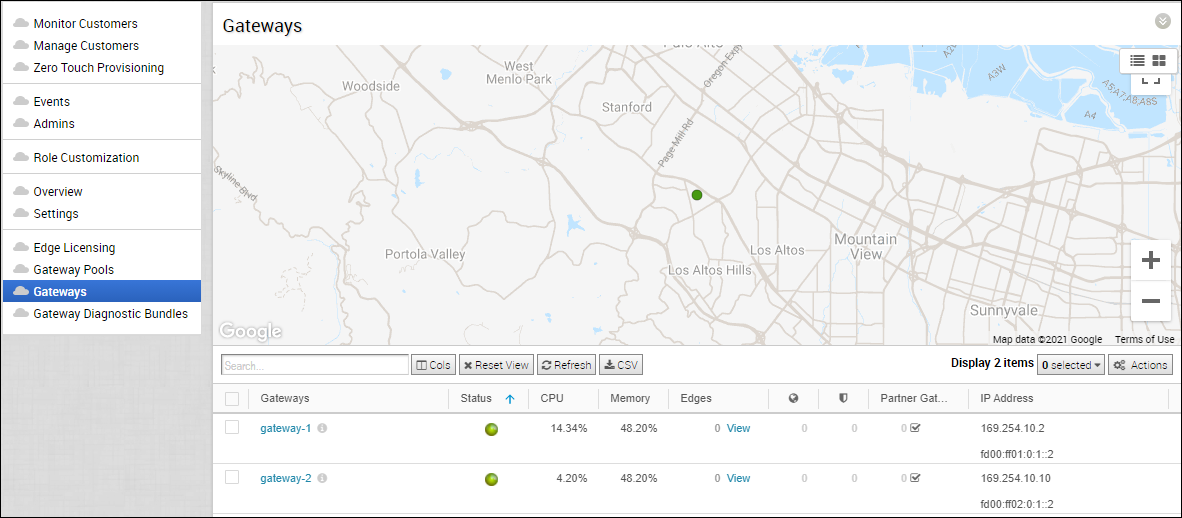VMware SD-WAN Gateways are a distributed network of gateways, deployed around the world or on-premises at service providers, provide scalability, redundancy and on-demand flexibility. The SD-WAN Gateways optimize data paths to all applications, branches, and data centers along with the ability to deliver network services to and from the cloud.
By default, the Gateways named as gateway-1 and gateway-2 are available when you install SD-WAN Orchestrator. If required, you can create additional Gateways.
In the Partner portal, click Gateways.
The Gateways window displays the existing Gateways with the following options:
- Search – Enter a term to search for a specific detail. Click the drop-down arrow to filter the view by a specific criteria.
- Cols – Click and select the columns to be shown or hidden in the view.
- Reset View – Click to reset the view to default settings.
- Refresh – Click to refresh the details displayed with the most current data.
- CSV – Click to download the data in CSV format.

The Gateways table displays the following details.
| Column | Description |
|---|---|
| Gateways | Name of the Gateway |
| Status |
Reflects the success or failure of periodic heartbeats sent by mgd to the Orchestrator and does not indicate the status of the data and control plane. The following are the possible statuses:
|
| CPU | Average CPU utilization of all the cores in the system at the time of the last heartbeat. |
| Memory | Percentage usage of the physical memory by all processes in the system as reported by psutil.phymem_usage at the time of the last heartbeat. This is similar to estimating the percentage of memory usage using the free command. |
| Edges | Number of Edges connected to the Gateway at the time of the last heartbeat.
Note: Click
View next to the number of Edges, to view all the Edges assigned to the Gateway as well as their online/offline status on the Orchestrator. This option does not display the Edges that are actually connected to the Gateway.
|
| Service State | The user-configured service state of the Gateway and whether it is eligible to be assigned to new Edges. |
| Super Gateway | The number of customers for which the Gateway has been chosen as a Super Gateway, which is a common route reflector for all Edges. |
| Secure VPN Gateway | Displays whether Secure VPN Gateway has been enabled on the Gateway, which allows the Gateway to be chosen as an endpoint for initiating Non SD-WAN Destination tunnels. |
| Partner Gateway | Displays whether Partner Gateway has been enabled on this Gateway, which allows the Gateway to be assigned as a Partner Gateway for Edges. |
| Certificates | If PKI is enabled, then you can view the generated Certificates. |
| IP Address | The public IP address that public WAN links of an Edge use to connect to the Gateway. This IP address is used to uniquely identify the Gateway. If the Gateway is enabled to accommodate both IPv4 and IPv6 addresses, this column displays both the IP addresses. |
| Pools | Displays the list of Gateway Pools that contain the Gateway. |
| Customers | Displays the list of customers assigned with the Gateway. |
| Version | Displays the version number of the software running on the Gateway at the time of the last heartbeat. |
| Build | The full string of the software running on the Gateway at the time of the last heartbeat. |
| Location | Location of the Gateway from GeoIP (by default) or as manually entered by the user. This is used for geographic assignment of the Gateway to Edges and should be verified. |
| Managed Gateway | Indicates whether the Gateway is eligible to be managed by a Partner or can only be managed by the Operator. |
Click Actions to perform the following activities:
Note: The following options are available only for Partners with Gateway management access activated. If Gateway management access is deactivated, partner has only read access and cannot manage or configure gateways.
- New Gateway – Creates a new Gateway. See Create New Gateway.
- Delete Gateway – Deletes the selected Gateway. You cannot delete a Gateway that is already being used by an Enterprise Customer.
- Support Request – Redirects to instructions on how to file a support request.